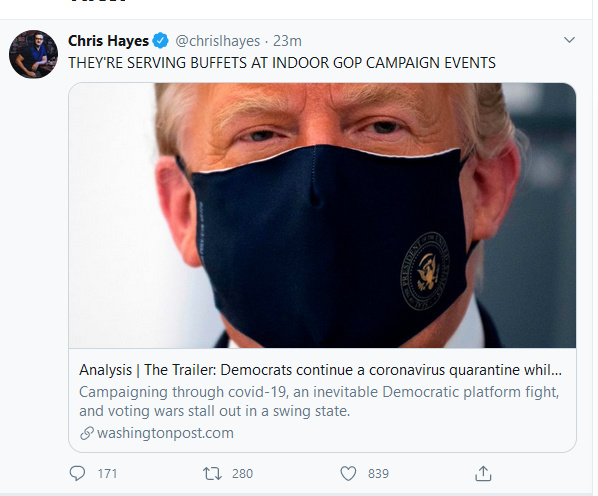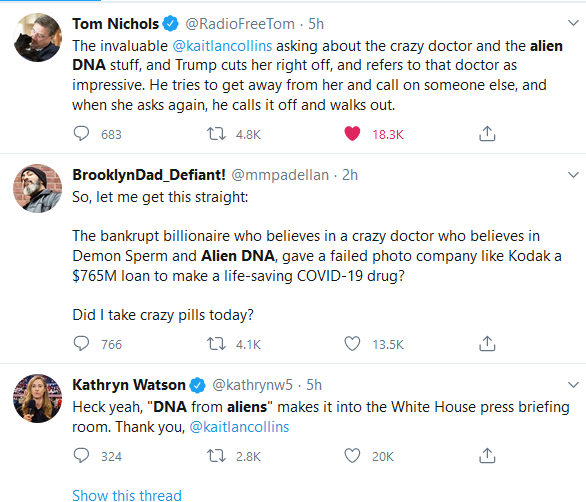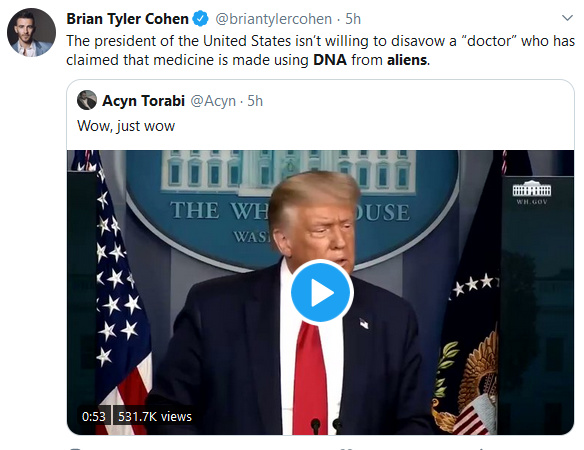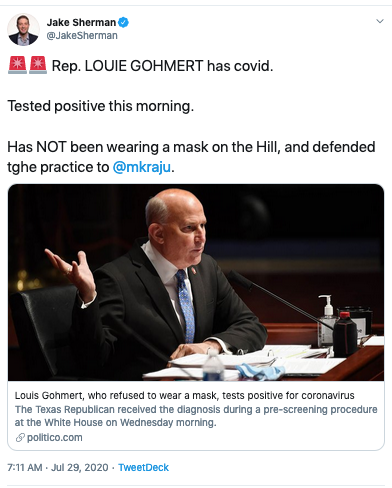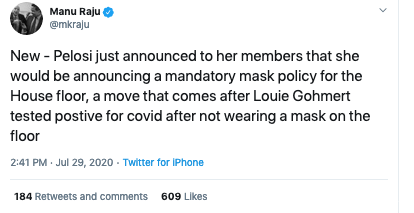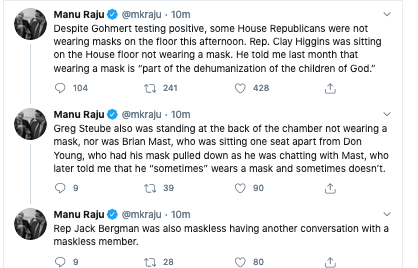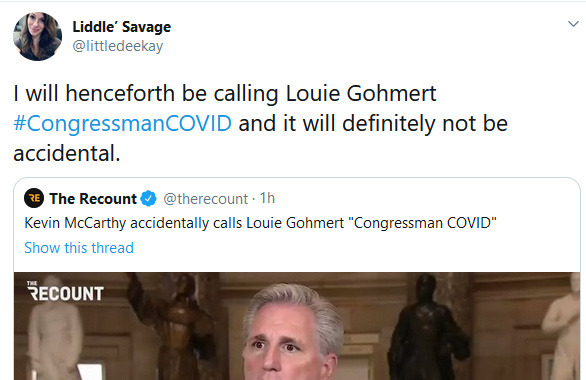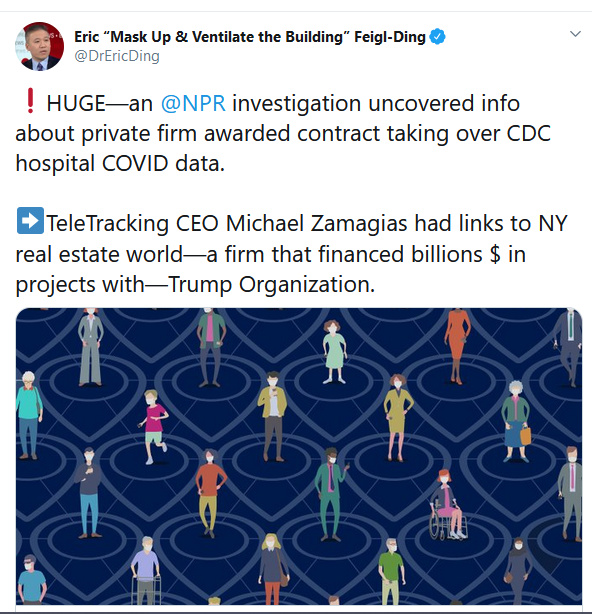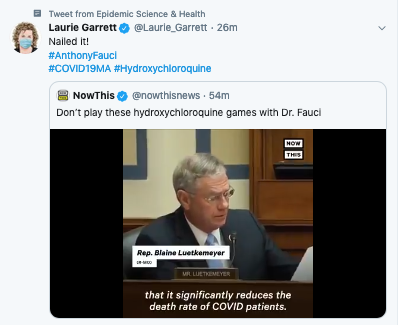At the Republican meet-and-greet here on Sunday night, masks were optional. Dinner was served from buffet trays, and taken back to tables where dozens of party activists sat next to each other. When it was over, candidates walked around the room, shaking hands.
It’s Buffet the Republican Slayer. 


Texas hospital forced to set up ‘death panel’ as Covid-19 cases surge
Starr County Memorial hospital struggling to cope with virus
Officials blame social gatherings for rise in local cases
this just made my entire damn day even thru the burn of the nose-snort of my coffee 
Check to see if you can do exposure and tracking for Covid-19 - it is the ‘big brother’ aspect of all of this…but it worth a look.
I tried it on my android - look under Play Store (google) and look for Exposure Notifications Systems. I found it, but there is no exposure counting in my part of town.


 yes! Just give everyone masks.
yes! Just give everyone masks.

No words 
Rep. Louie Gohmert — a Texas Republican who has been walking around the Capitol without a mask — has tested positive for the coronavirus, according to multiple sources.
Gohmert was scheduled to fly to Texas on Wednesday morning with President Donald Trump and tested positive in a pre-screen at the White House. The eighth-term Republican told CNN last month that he was not wearing a mask because he was being tested regularly for the coronavirus.
“[I]f I get it," he told CNN in June, "you’ll never see me without a mask.”
Reps. Mario Diaz Balart (R-Fla.), Neal Dunn (R-Fla.), Morgan Griffith (R-Va.), Mike Kelly (R-Pa.), Ben McAdams (D-Utah) and Tom Rice (R-S.C.) have tested positive for the virus, along with Sen. Rand Paul (R-Ky.).
In May, Speaker Nancy Pelosi (D-Calif.) and Senate Majority Leader Mitch McConnell (R-Ky.) turned down the administration’s offer of rapid testing for the Capitol. Some lawmakers — mostly Republicans — decline to use face coverings while in the building.
Gohmert attended Tuesday’s blockbuster House Judiciary Committee hearing with Attorney General William Barr in person, where lawmakers were seated at some distance from one another.
No Evidence That America’s Frontline Doctors Group in Viral Video Got Near COVID ‘Front Lines’
None of them have practices that would place them on the actual front lines of the COVID-19 pandemic. Some don’t currently practice at all.
Coronavirus Deaths Top 150,000 in the U.S.
An average of about 1,000 virus-related deaths a day have been reported over the past week, the worst rate since early June.
Judge Blocks Green Card Wealth Tests, Citing Pandemic Hardships - The New York Times
What… the… hell.
Welcome home, now pay up: Thousands await big bills for virus repatriation flights
The State Department says it’s bound by statute to get reimbursement for repatriation flights.
Americans stranded abroad as the coronavirus spread took a lifeline offered by the State Department: We’ll fly you home, but you have to pay us back.
Some Americans had to use passports as collateral for loans — but months later, they’re still waiting for a bill, so their passports are invalid. Others signed promissory notes agreeing to pay an eventual bill they’re still waiting for, and dreading a price tag that for a family of four could weigh in at $10,000.
State has flown home about 100,000 U.S. citizens home from nearly 150 countries since the pandemic began, at a cost of $196 million to the agency, which it must collect from passengers. Of that sum, about $8 million comes from direct loans secured with a passport.
Desperate to get home to California from Peru, Ash Maki took out a direct loan from the agency, guaranteed by his passport. It was stamped to indicate it would be invalid after five days and only good for one return entry. He said he was told that he’ll have to apply for a new passport and that it would only be approved after he repays the repatriation loan in full.
There’s just one problem: He’s still waiting for a bill. In the meantime, Maki, an American citizen, has a passport that can’t be used.
“It was supposed to be 8-10 weeks from the date of travel, and it’s now been three months,” Maki said. “They are basically holding us hostage until they decide that it’s convenient for them.”
The State Department says it’s bound by statute to get reimbursement for repatriation flights.
“It’s a matter of statute. The Department of State does not have a choice in that matter. We are not in a position to forgive those loans given the statute,” said deputy assistant secretary for consular affairs Karin King, after being pressed at a recent congressional hearing.
Though those untold thousands took direct loans, the main method of payment for State-chartered repatriation flights was promissory notes, without anything more than an estimate of how much it might cost. Most of the people repatriated, especially in the beginning of the department’s efforts, were handed blank documents which they had to sign before they got on the plane, promising to pay back the government when billed.
And though they didn’t get their passports invalidated, they’re still waiting for bills, too — and dreading the unknown price tag, even as the country racks up record-high unemployment numbers.
One family is checking the mailbox every day, dreading a charge as high as $10,000.
Daniel Musick and his wife and two children had lived in northern India for three years, but as the coronavirus situation got worse and the U.S. Embassy started issuing dire warnings, they decided they would be safest in the U.S.
By then, commercial flights had shut down and their only choice was a State repatriation flight operated by United Airlines.
Musick doesn’t know how much their bill will be yet, but he was told by an embassy official at the airport that it would be near $2,500 per person. Another point of uncertainty is whether Musick will be billed for his one-year-old son, who didn’t take up a seat.
“I’m not looking for a free flight,” he said in an interview with POLITICO. But for a family of four with two teachers’ incomes, they’re dreading — and expecting — an overwhelming bill. “I have no idea how we’re going to pay for it,” Musick said.
Others are also still awaiting bills as much as four months later, according to interviews with 6 people who took flights from India, Peru and Guatemala in March and April.
Beyond the wait, they also don’t know what the price tag will ultimately be. Embassy officials at best would give rough estimates, which in at least one case increased four times as the flight approached.
Zara Bloom, who was trying to get home from Lima, Peru, said signing the blank promissory note was “super frightening” but she felt like she had no choice. She has lost her job since returning home and said she doesn’t think she’ll be able to pay a large bill. She, like others, doesn’t know what amount to expect.
There are at least two bills in play in Congress which would change that, both introduced earlier this year. However, neither has moved beyond being introduced.
“If you’re having to have the State Department fly you out, it is not a good or safe situation. And a lot of these families can’t afford it, frankly,” said Rep. Debbie Dingell (D-Mich.), the sponsor of one of the bills in an interview. “The cost is coming in really high.” Rep. Nydia Velazquez has sponsored a similar bill which has 35 cosponsors, including several Republicans.
Dingell noted that other countries have not asked for reimbursement from their citizens for repatriation flights during the pandemic, and said that Americans shouldn’t have to pay either.
“This is what we have to do. That’s one of the jobs of the State Department,” she said.
Unfortunate news…last seen at the Tulsa MAGA Rally, not wearing a mask. 
Going on today NOW on CSpan - July 31 7AM PST
Irregularities In COVID Reporting Contract Award Process Raises New Questions
An NPR investigation has found irregularities in the process by which the Trump administration awarded a multi-million dollar contract to a Pittsburgh company to collect key data about COVID-19 from the country’s hospitals.
The contract is at the center of a controversy over the administration’s decision to move that data reporting function from the Centers for Disease Control and Prevention — which has tracked infection information for a range of illnesses for years — to the Department of Health and Human Services.
TeleTracking Technologies, the company that won the contract, has traditionally focused on creating software for hospitals to track patient status. And there are questions about how it came to be responsible for gathering data in the midst of a pandemic.
Among the findings of the NPR investigation:
The Department of Health and Human Services initially characterized the contract with TeleTracking as a no-bid contract. When asked about that, HHS said there was a "coding error" and that the contract was actually competitively bid. The process by which HHS awarded the contract is normally used for innovative scientific research, not the building of government databases. HHS had directly phoned the company about the contract, according to a company spokesperson. TeleTracking CEO Michael Zamagias had links to the New York real estate world — and in particular, a firm that financed billions of dollars in projects with the Trump Organization.An abrupt change during the pandemic
When the Department of Health and Human Services, which oversees the CDC, sent out a directive to the nation’s hospitals in April announcing it would be using TeleTracking as an option to collect COVID data, Carrie Kroll didn’t give it a second thought.
It just seemed like one more form hospitals might need to fill out.
Kroll is with the Texas Hospital Association, and balked only after the HHS suddenly announced in July that hospitals could no longer report COVID data through the CDC, but would instead be required to do so through the HHS-TeleTracking system or their state health departments.
This is the sort of data that has been closely watched since the outbreak of the pandemic: from beds, to personal protective equipment (PPE), to detailed demographic information on suspected and confirmed COVID patients.
“Up until the switch, we were reporting about 70 elements and we’re now at 129,” Kroll said, scrolling through a five-page list of the information now required. “I mean, clearly we’re in the middle of a pandemic, right? I mean this isn’t the type of stuff you try to do in the middle of a pandemic.”
Hospitals were only given days to start sending all this information to TeleTracking. The HHS explained the sudden change by claiming the new database would streamline information gathering and help in the allocation of therapeutic pharmaceuticals like remdesivir.
But thousands of hospitals had used the CDC system for years to report infection control data. So it raised questions: Why the change? Why now?
The CDC has been tracking these numbers for some 15 years. And while its system isn’t perfect — it requires all the information to be entered manually, for example — it is unclear why the government, already underwater with the spread of COVID, didn’t decide instead to tinker with the existing system.
Robert Redfield, the CDC’s director, said the reason HHS chose TeleTracking was because it provided “rapid ways to update the type of data that we’re collecting” and that it “reduces the reporting burden,” none of which, given the duplication of Kroll’s experience around the country, seems to be happening.
The TeleTracking software, for example, requires all the data to be keyed in manually, just like the CDC once did.
An HHS spokesperson said that the COVID response required that they move quickly to implement a new system, “even when more time might be desired. We acknowledge that hospitals were not given significant lead time to prepare for these changes.”
TeleTracking’s ties to Trump Organization financiers
The CEO of the company, Michael Zamagias, came from the real estate sector. He founded Zamagias Properties, a real estate investment and development company, in Pittsburgh, Pa., in 1987.
The company went on to develop iconic office buildings, shopping centers and malls in Pittsburgh and Virginia, and its success helped Zamagias become a fixture outside Pittsburgh and, in particular, in the New York real estate scene.
Zamagias is a longtime Republican donor and community philanthropist, giving generously to Pittsburgh schools and youth programs.
One of the young people who came to Zamagias for advice and counsel was a New Yorker named Neal Cooper, though he was hardly new to business or real estate. Zamagias became the young Cooper’s mentor. He gave Cooper an internship.
Neal’s father, Howard, was the named partner in a Manhattan company called Cooper-Horowitz, one of the largest privately held real estate debt and equity firms in the country.
“Cooper did business with Michael in the late 1980s,” Neal Cooper told NPR, referring to his dad’s company. “I don’t know if we ever did big deals with him, but we ran in the same circles. I learned a lot from Michael. He was always one or two steps ahead of the next guy.”
Cooper-Horowitz handles debt and equity in all classes of real estate and specializes in the hospitality industry.
And in that vein, it did billions of dollars of work with the Trump Organization on projects like the Trump International Hotel & Tower in Chicago.
“I didn’t handle Trump’s account, but I’ve been in meetings with Trump,” Cooper said. “We did tons of business with him, billions of dollars of business.”
And there are other suggestions of a close relationship between Cooper-Horowitz and the Trumps.
Ivanka Trump has attended a rather famous holiday party the company holds in New York every year. The firm has given to the Trump Foundation. And Richard Horowitz, one of the company’s principals, is credited with helping connect the Trump Organization with Deutsche Bank, the German bank that has financed over $2 billion in Trump projects over the past two decades.
There’s no evidence that these professional relationships are why Zamagias and TeleTracking received the multi-million dollar contract. Through a spokesperson Zamagias said that he hadn’t talked to anyone at Cooper-Horowitz in years, and all his company’s contact with the administration came through HHS.
But congressional investigators are now eager to find out if that relationship somehow played a role.
The White House did not respond to questions about whether it was involved in the awarding of the TeleTracking contract, or whether White House staff had any relationship with Zamagias.
An unusual contracting process leads to multi-million dollar TeleTracking deal
Initially, there was confusion about the way HHS awarded the contract to TeleTracking. Public records originally displayed it as a sole-source contract — essentially a no-bid deal.
But after a Senate inquiry and controversy over the mandatory shift to the TeleTracking system, HHS said that there had been a “coding error” and that it had in fact been awarded after a competitive process.
“The TeleTracking contract was part of a competitive solicitation process and was not sole source,” an HHS spokesperson said. “One of the websites that tracks federal spending contained an error that incorrectly categorized the award as sole source. That coding error is being corrected.”
That competitive process, HHS said, is known as a Broad Agency Announcement.BAAs are essentially call-outs to private industry to provide innovative solutions to general problems in which a simple straightforward solution may not be available — it isn’t meant for something like a government database that replaces an existing CDC function.
A standard government contract would usually lay out a series of specific requirements or specifications. Not so with BAAs. By their very nature, they are less competitive than other types of government contracting processes because they may generate an array of solutions that may not necessarily be comparable.
In a statement, an HHS spokesperson said that the BAA is a “common mechanism… for areas of research interest,” and asserted that the healthcare system capacity tracking system previously used by the CDC was “fraught with challenges.”
HHS has said that six companies bid for the contract but declines to say who they were or release the evaluations that the department would have done before awarding the contract to TeleTracking.
“Federal acquisition regulations and statutes prohibit us from providing information about other submissions,” an HHS spokesperson said. The spokesperson added that the BAA was released in August 2019, and that the agency promoted it on social media, in newsletters, and in emails.
But NPR reached out to more than 20 of TeleTracking’s competitors in the fields of hospital workflow management and infection control data and was unable to find a single company that said it had bid on this contract.
One major company told NPR that it hadn’t even heard about the HHS announcement.
There is another wrinkle here. A spokesperson for Zamagias told NPR that HHS reached out to the company directly — by phone — because it knew the company from its hurricane and disaster preparedness work.
It is unclear when that phone call was made.
Congressional investigators probe HHS and TeleTracking
The whole process by which TeleTracking got the contract strikes Virginia Canter, chief ethics counsel at Citizens for Responsibility and Ethics in Washington, as out of the ordinary.
It isn’t just the use of the BAA. It is that HHS “now requires 6,000 hospitals to enter this data” in what looks like proprietary software, which the federal government may need to pay for in the future, Canter said the current contract ends in September. The Zamagias spokesperson told NPR that TeleTracking hopes for a contract extension — and that potentially means millions of dollars more in the future.
“We do anticipate needing to continue this contract,” an HHS spokesperson said.
Congress is also looking into irregularities in the contract process and the decision to shift the data gathering from CDC to HHS. Sen. Patty Murray, a prominent Democrat on health care, first raised questions about the HHS contract in early June.
And Rep. James Clyburn, who chairs a congressional subcommittee overseeing the coronavirus crisis, and House Oversight Committee Chairwoman Carolyn Maloney are both demanding answers about what happened.
While the inquiries were originally focused on HHS, Clyburn sent a letter to Zamagias Tuesday asking for information on the contracts, emails and communication exchanged with HHS in a bid to understand how TeleTracking came to land the $10.2 million six-month contract in the middle of a pandemic.
“Your company has previously been awarded a handful of small contracts with the Department of Veteran’s Affairs, but your contract with HHS is nearly twenty times larger than all of your previous federal contracts combined,” Clyburn wrote in his letter to Zamagias.
The congressional underclass erupts in fury after Gohmert gets Covid-19
The men and women who make Capitol Hill run are anxious and angry about the risks they’ve been forced to take amid the pandemic.
The revelation Wednesday that Texas Republican Louie Gohmert, a renegade lawmaker known for stalking the halls of Congress without a mask, tested positive for Covid-19 has unleashed a fusillade of anger on Capitol Hill — a sudden release of built-up tension over how the institution has dealt with the coronavirus pandemic within the confines of its own workplace.
For months, the leaders of Congress have allowed lawmakers to enter the Capitol without being screened for the deadly virus, rejecting an offer from the White House to provide rapid testing while trusting that the thousands who work across the massive complex of offices, meeting rooms and hallways will behave responsibly.
Now, legislative aides, chiefs of staff, press assistants, members of Congress, career workers and maintenance men and women are venting their fury with an institution that does not have uniform rules or masking requirements, does not mandate testing, is run with minimal oversight and must contend with a gaggle of lawmakers who doubt scientists and hold themselves out as experts on everything from disease hygiene to pharmacology.
Congress is often buffeted by waves of popular discontent from voters, but what’s happened in recent days has the makings of a historical anomaly: The backlash is coming from the anonymous staff and members who make the place run day to day but are typically accustomed to being told to know their place and accepting that without complaint.
In a nation on edge — and with workplace culture undergoing a generational shift — Congress is now getting a small taste of the same type of internal turbulence that can rock the leaders of The New York Times over an offending op-ed or superintendents of local school systems whose teachers are worried about whether it’s safe to return to the classroom.
“There is a general fear that saying anything critical of the current office policy — or lack of policy — will lead to retaliation,” said an aide to a Republican lawmaker who had been infected, one of a slew of staffers who spoke to POLITICO about their anxiety working in the Capitol.
Other lawmakers have come down with Covid-19. But in many ways, Gohmert’s diagnosis has become a tipping point for a sprawling complex where hundreds of people stream in and out daily, with little institutional guidance.
Hours after Gohmert tested positive — the second case among GOP lawmakers in three weeks — Speaker Nancy Pelosi swiftly implemented a mask mandate for House office buildings and the chamber itself. House Republican leaders recirculated a memo to stress guidance from the Capitol physician, such as limiting or rotating staff, encouraging masks, and implementing home temperature checks.
“The reporting on this situation has led to other reports suggesting House staff reporting unsafe work conditions,” the GOP memo, obtained by POLITICO reads.
Rep. Rodney Davis of Illinois, the top Republican on the House Administration Committee, also delivered a brief presentation on office safety at a private GOP Conference meeting on Thursday.
“Follow OAP and AOC guidance. Take advantage of supplies and thermometers every office can get at no cost to MRA. And lastly, don’t be stupid and become the news story of the day,” Davis said afterward, recalling his message to his fellow Republicans.
Reporters’ inboxes have exploded with complaints and tales of lax safety measures, careless bosses and a widespread feeling that their health was viewed as expendable.
Many described feeling uncomfortable taking the very kinds of health steps recommended by public health experts, and feeling pressured to report to work in person despite the risks. Multiple aides said it was common to mock those wearing masks, or brush off concerns among staff members with specific health issues.
Others recalled seeing aides avoid taking elevator rides with certain members out of fear of contracting the virus — an almost unheard-of reversal of the usual dynamics of power in a place teeming with ambition and hierarchy.
“Our office has been required to be fully staffed since session resumed at the end of June (including an intern),” a scheduler for a House Republican member said. “While mask use isn’t banned, it’s also not encouraged, and has been derided on several occasions by the [chief of staff] and the member.”
Another aide to a House GOP member told of how staff were allowed to work from home for several days when an office colleague was thought to have been exposed. “Even then,” this person said, “many of my colleagues kept working in the office. We were told to report to work as normal even before the test came back negative because the results were taking too long. I was left feeling guilty for teleworking even though I have an underlying health condition.”
An administrative staffer who often visits multiple offices estimated that mask wearing was “nearly universal in Democratic offices” but was “probably under 50 percent” among Republicans.
Masking has become a “political minefield” that creates awkward encounters on occasion, this person recounted: “[S]ome GOP offices ask why you are wearing a mask, which puts our staff in an awkward position — do you say because of the pandemic and risk the office taking that as a political stand? Do you take it off to make them feel better?”
Staffers with limited recourse
Since the House began voting regularly again this summer, dozens, if not hundreds, of offices have reopened in some capacity, many with a skeleton crew but others — particularly GOP members — that have required nearly the entire staff to return to work in person.
And the return of hundreds of staffers has resurfaced a decades-old problem for the Capitol: More than 25 years after the Congressional Accountability Act passed in an attempt to reform the culture on Capitol Hill, it’s still an often brutal, unforgiving place to work.
Part of the problem is the scattershot human resources system spread across the Capitol complex. There is no centralized HR department — each of the 535 lawmakers and senators is his or her own employer, with their own set of office policies and protocols.
Staffers who may be uncomfortable with what’s happening in an office sometimes have limited recourse. For example, if a staffer is uncomfortable with the mask policies in an office, that person can reach out to the Office of Employee Advocacy — which provides free legal counsel to House staffers — or the Office of Congressional Workplace Rights.
But there isn’t some centralized database tracking staffer complaints or concerns, just like there isn’t a singular database to track potential coronavirus infections among the more than 20,000 workers who inhabit the Capitol complex, thousands of staffers and hundreds of lawmakers.
At least 86 Capitol workers have tested positive for coronavirus, according to a House aide familiar with the data. That includes 25 Architect of the Capitol employees, 28 Capitol police officers and 33 people working on the renovation of the Cannon building. But reporting is voluntary and doesn’t include data for House staffers or lawmakers who have tested positive.
Other aides note that overall, there appear to be relatively few coronavirus cases on Capitol Hill, suggesting many offices are indeed following public health guidelines.
Despite the swift move to mandate masks in the House earlier this week, Democratic aides say it’s unlikely Congress will start requiring testing for members, despite calls by some Republicans to do so. Republicans, those Democratic aides say, aren’t being fully truthful about the logistics of implementing a regular testing regime for hundreds of lawmakers and the Capitol staff and aides who would also need to be tested.
Instead, Democrats think the best solution is to fully enforce current policies, including the new mask mandate. If a member refuses to wear a mask on the House floor or in the connected office buildings and brushes off several warnings to do so, it is much more likely he or she will be escorted from the area until complying, according to Democratic aides familiar with the policy.
On the Senate side, Majority Leader Mitch McConnell has urged people to wear masks, though he remains skeptical about the need to require them. Asked about the idea recently by Judy Woodruff of PBS, he said the Senate had experienced “good compliance” without a mandate. Pressed further, he said, “It appears not to be necessary since everybody seems to be doing it.”
Also, something overlooked in the previous Politico story:
Asked by a Politico reporter for comment, an aide to Congressmember Gohmert wrote, “Thank you for letting our office know Louie tested positive for the Coronavirus.” The aide added: “When you write your story, can you include the fact that Louie requires full staff to be in the office, including three interns, so that ‘we could be an example to America on how to open up safely.’ When probing the office, you might want to ask how often were people berated for wearing masks.”
This means that the staff found out from the reporter, NOT Gohmert!
Dr. Fauci rebutts this Rep Luetkemeyer’s assertion that a study had been done showing Hydroxycloroquine’s does heal patients. Dr. Fauci for the 1000th time tells him it was not a placebo controlled study, and therefore not effective. Oh, and that the patients had been given steroids, which always helps in healing.
Video -
Jared Kushner did help create a national testing plan, but it was going to help blue states so they decided to scrap it…according to this Vanity Fair Article.
Though Kushner’s outsized role has been widely reported, the procurement of Chinese-made test kits is being disclosed here for the first time. So is an even more extraordinary effort that Kushner oversaw: a secret project to devise a comprehensive plan that would have massively ramped up and coordinated testing for COVID-19 at the federal level.
Six months into the pandemic, the United States continues to suffer the worst outbreak of COVID-19 in the developed world. Considerable blame belongs to a federal response that offloaded responsibility for the crucial task of testing to the states. The irony is that, after assembling the team that came up with an aggressive and ambitious national testing plan, Kushner then appears to have decided, for reasons that remain murky, to scrap its proposal. Today, as governors and mayors scramble to stamp out epidemics plaguing their populations, philanthropists at the Rockefeller Foundation are working to fill the void and organize enough testing to bring the nationwide epidemic under control.
Inside the White House, over much of March and early April, Kushner’s handpicked group of young business associates, which included a former college roommate, teamed up with several top experts from the diagnostic-testing industry. Together, they hammered out the outline of a national testing strategy. The group—working night and day, using the encrypted platform WhatsApp—emerged with a detailed plan obtained by Vanity Fair.
Rather than have states fight each other for scarce diagnostic tests and limited lab capacity, the plan would have set up a system of national oversight and coordination to surge supplies, allocate test kits, lift regulatory and contractual roadblocks, and establish a widespread virus surveillance system by the fall, to help pinpoint subsequent outbreaks.
The solutions it proposed weren’t rocket science—or even comparable to the dauntingly complex undertaking of developing a new vaccine. Any national plan to address testing deficits would likely be more on the level of “replicating UPS for an industry,” said Dr. Mike Pellini, the managing partner of Section 32, a technology and health care venture capital fund. “Imagine if UPS or FedEx didn’t have infrastructure to connect all the dots. It would be complete chaos.”
The plan crafted at the White House, then, set out to connect the dots. Some of those who worked on the plan were told that it would be presented to President Trump and likely announced in the Rose Garden in early April. “I was beyond optimistic,” said one participant. “My understanding was that the final document would make its way to the president over that weekend” and would result in a “significant announcement.”
But no nationally coordinated testing strategy was ever announced. The plan, according to the participant, “just went poof into thin air.”
In a statement, White House press secretary Kayleigh McEnany said, “The premise of this article is completely false.”
This summer has illustrated in devastating detail the human and economic cost of not launching a system of national testing, which most every other industrialized nation has done. South Korea serves as the gold standard, with innovative “phone booth” and drive-through testing sites, results that get returned within 24 hours, and supportive isolation for those who test positive, including food drop-offs.
In the U.S., by contrast, cable news and front pages have been dominated by images of miles-long lines of cars in scorching Arizona and Texas heat, their drivers waiting hours for scarce diagnostic tests, and desperate Sunbelt mayors pleading in vain for federal help to expand testing capacity. In short, a “freaking debacle,” as one top public health expert put it.
We are just weeks away from dangerous and controversial school reopenings and the looming fall flu season, which the aborted plan had accounted for as a critical deadline for establishing a national system for quickly identifying new outbreaks and hot spots.
Without systematic testing, “We might as well put duct tape over our eyes, cotton in our ears, and hide under the bed,” said Dr. Margaret Bourdeaux, research director for the Harvard Medical School Program in Global Public Policy.
As it evolved, Kushner’s group called on the help of several top diagnostic-testing experts. Together, they worked around the clock, and through a forest of WhatsApp messages. The effort of the White House team was “apolitical,” said the participant, and undertaken “with the nation’s best interests in mind.”
Kushner’s team hammered out a detailed plan, which Vanity Fair obtained. It stated, “Current challenges that need to be resolved include uneven testing capacity and supplies throughout the US, both between and within regions, significant delays in reporting results (4-11 days), and national supply chain constraints, such as PPE, swabs, and certain testing reagents.”
The plan called for the federal government to coordinate distribution of test kits, so they could be surged to heavily affected areas, and oversee a national contact-tracing infrastructure. It also proposed lifting contract restrictions on where doctors and hospitals send tests, allowing any laboratory with capacity to test any sample. It proposed a massive scale-up of antibody testing to facilitate a return to work. It called for mandating that all COVID-19 test results from any kind of testing, taken anywhere, be reported to a national repository as well as to state and local health departments.
And it proposed establishing “a national Sentinel Surveillance System” with “real-time intelligence capabilities to understand leading indicators where hot spots are arising and where the risks are high vs. where people can get back to work.”
By early April, some who worked on the plan were given the strong impression that it would soon be shared with President Trump and announced by the White House. The plan, though imperfect, was a starting point. Simply working together as a nation on it “would have put us in a fundamentally different place,” said the participant.
But the effort ran headlong into shifting sentiment at the White House. Trusting his vaunted political instincts, President Trump had been downplaying concerns about the virus and spreading misinformation about it—efforts that were soon amplified by Republican elected officials and right-wing media figures. Worried about the stock market and his reelection prospects, Trump also feared that more testing would only lead to higher case counts and more bad publicity. Meanwhile, Dr. Deborah Birx, the White House’s coronavirus response coordinator, was reportedly sharing models with senior staff that optimistically—and erroneously, it would turn out—predicted the virus would soon fade away.
Against that background, the prospect of launching a large-scale national plan was losing favor, said one public health expert in frequent contact with the White House’s official coronavirus task force.
Most troubling of all, perhaps, was a sentiment the expert said a member of Kushner’s team expressed: that because the virus had hit blue states hardest, a national plan was unnecessary and would not make sense politically. “The political folks believed that because it was going to be relegated to Democratic states, that they could blame those governors, and that would be an effective political strategy,” said the expert.That logic may have swayed Kushner. “It was very clear that Jared was ultimately the decision maker as to what [plan] was going to come out,” the expert said.
Exclusive: CDC projects U.S. coronavirus death toll could top 180,000 by Aug. 22
As coronavirus cases have continued to rise in the U.S. throughout the summer, the Centers for Disease Control and Prevention is forecasting that the total American death toll from COVID-19 could hit 182,000 by the fourth week of August, according to an internal government document obtained by Yahoo News.
More than 150,000 Americans have died due to the coronavirus as of Thursday, according to the latest CDC numbers, which were included in a July 30 senior leadership brief.
Here’s the next level projections…
A new model from the Institute for Health Metrics and Evaluation (IHME) released Thursday increased the United States’ death projection to over 230,000 by early November.
A IHME forecast released July 22 projected 219,864 deaths in the United States, but the latest model estimates 230,822 deaths by Nov. 1, an increase of nearly 11,000 more deaths.
If individual states ease mask restrictions IHME projected 250,000 deaths due to COVID-19 in the United States.
With citizens universally wearing masks, IHME projected 198,000 COVID-19 deaths, a decrease of 32,000 deaths from the agency’s projected mark.
